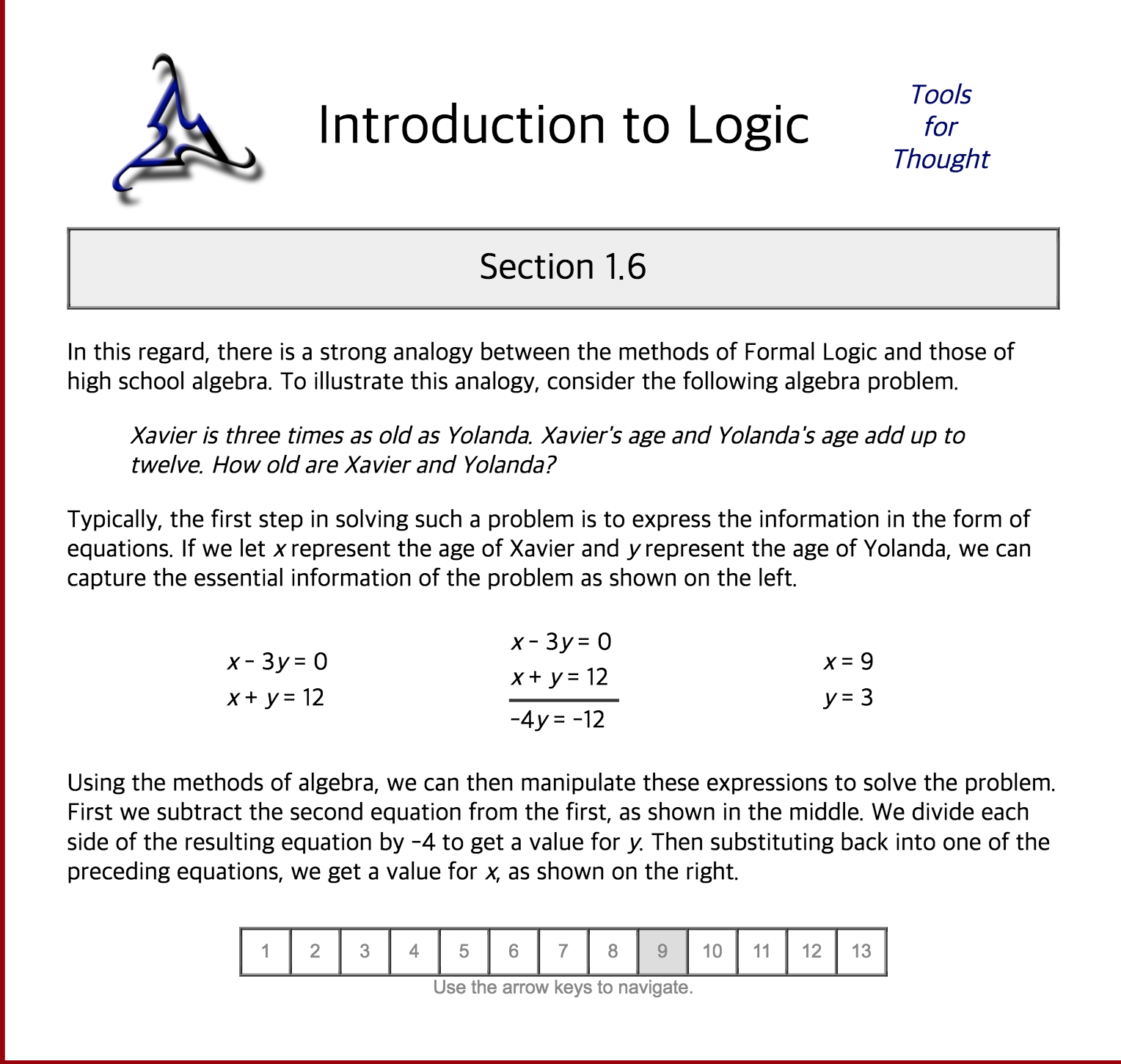section 1.2
두 명의...다른 소녀??
section 1.4
Note that, when there are multiple possible worlds, as in this case, there are sentences that we do not know to be true or false. For example, in the case above, there is a possible world in which Abby likes Bess and there is a possible world in which Abby does not like Bess. The upshot is that the statement Abby likes Bess is not a logical conclusion; and, at the same time, the statement that Abby does not likes Bess is not a logical conclusion either. Obviously, one of these statements is true in the real world, but we do not know which is true purely on the basis of the information we are given.
section 1.5
contents doesn’t matter to know and practice logic rather formation is more important to understand
All x are y.
All y are z.
Therefore, all x are z.
All x are y.
Some y are z.
Therefore, some x are z.
이런 경우에 추론이 필요쓰
What distinguishes a correct pattern from one that is incorrect is that it must always lead to correct conclusions, i.e. they must be correct so long as the premises on which they are based are correct. As we will see, this is the defining criterion for what we call deduction.
Induction
Induction is reasoning from the particular to the general. The example shown below illustrates this. If we see enough cases in which something is true and we never see a case in which it is false, we tend to conclude that it is always true.
I have seen 1000 black ravens.
I have never seen a raven that is not black.
Therefore, every raven is black.
Abduction
Abduction is reasoning from effects to possible causes. Many things can cause an observed result. We often tend to infer a cause even when our enumeration of possible causes is incomplete.
If there is no fuel, the car will not start.
If there is no spark, the car will not start.
There is spark.
The car will not start.
Therefore, there is no fuel.
Reasoning by analogy
Reasoning by analogy is reasoning in which we infer a conclusion based on similarity of two situations, as in the following example.
The flow in a pipe is proportional to its diameter.
Wires are like pipes.
Therefore, the current in a wire is proportional to diameter.
Now try price
—————
Propositional logic
simple sentences(proposition constants)
should be written as a lower case letter.
compound sentence
There are five types of compound sentences, viz. negations, conjunctions, disjunctions, implications, and biconditionals.
operator precedence = hierarchy of precedence = order of priority
¬
∧
∨
⇒
⇔
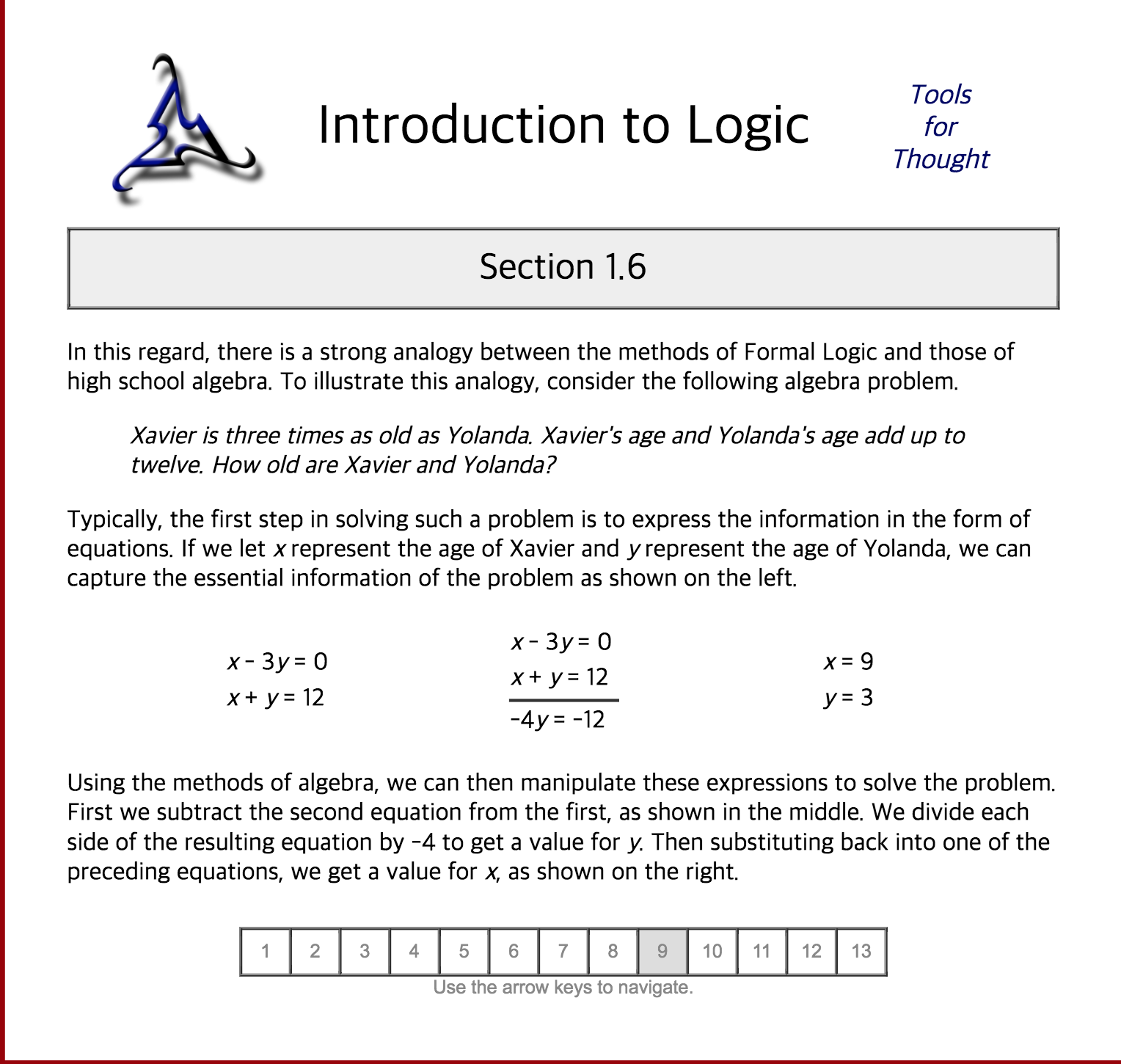
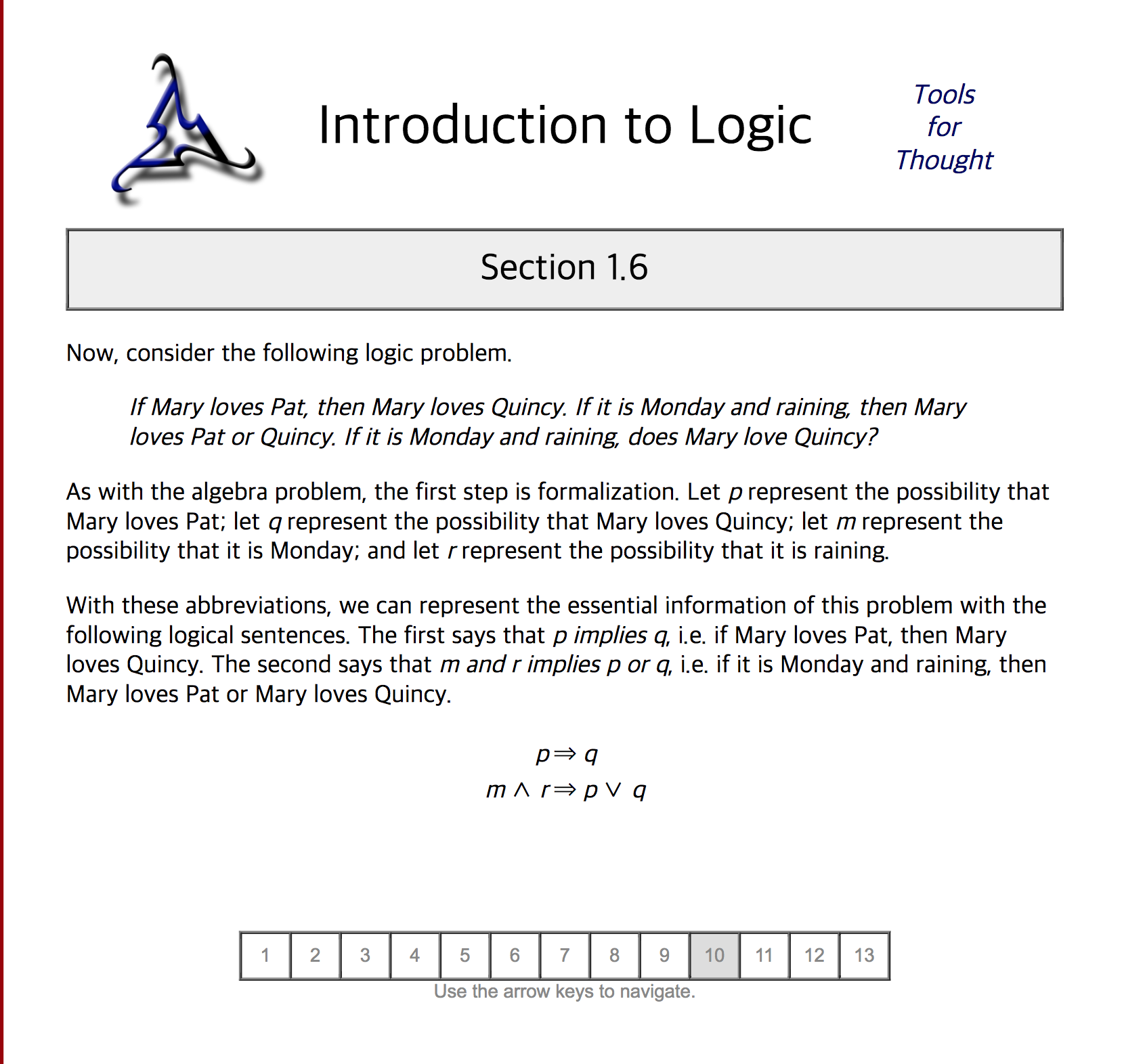
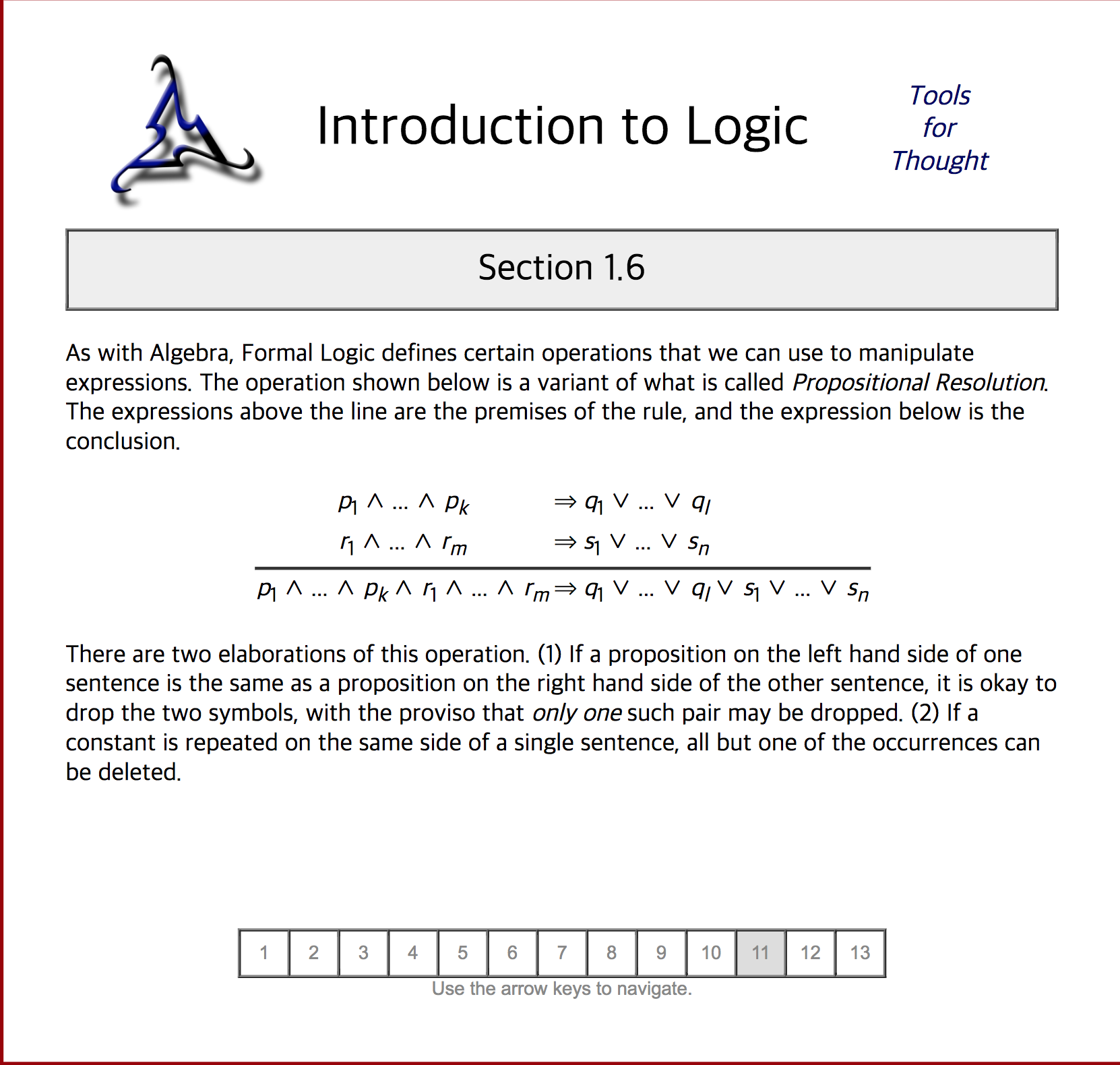
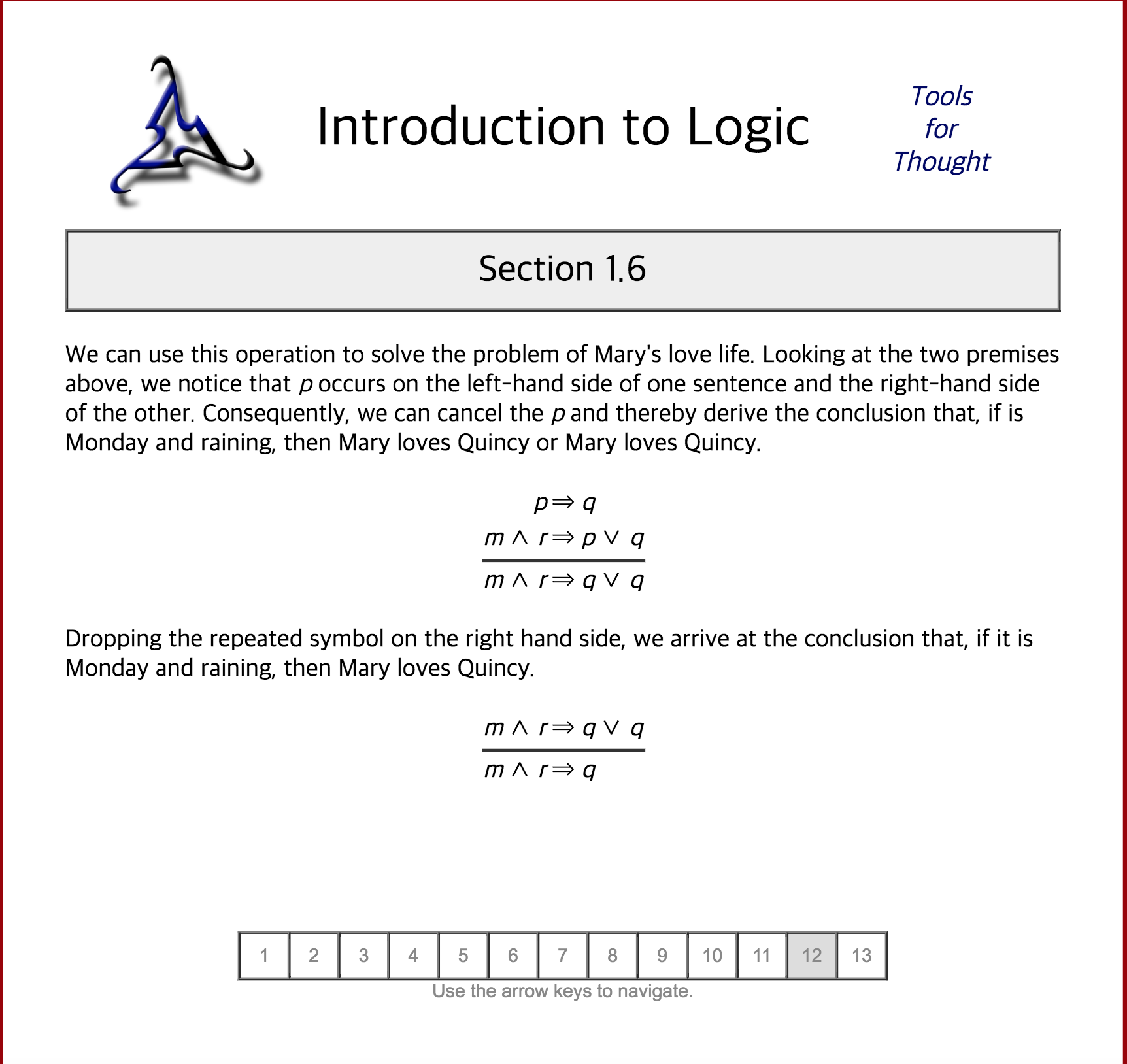
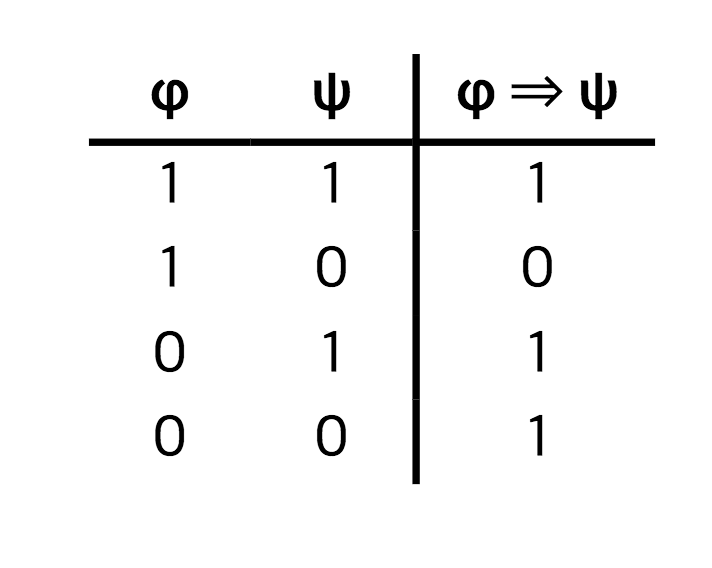
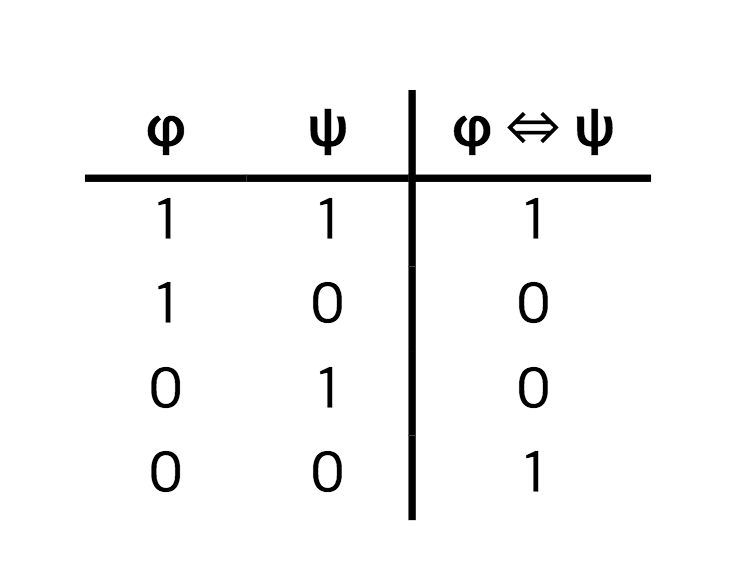
2.4 Evaluation
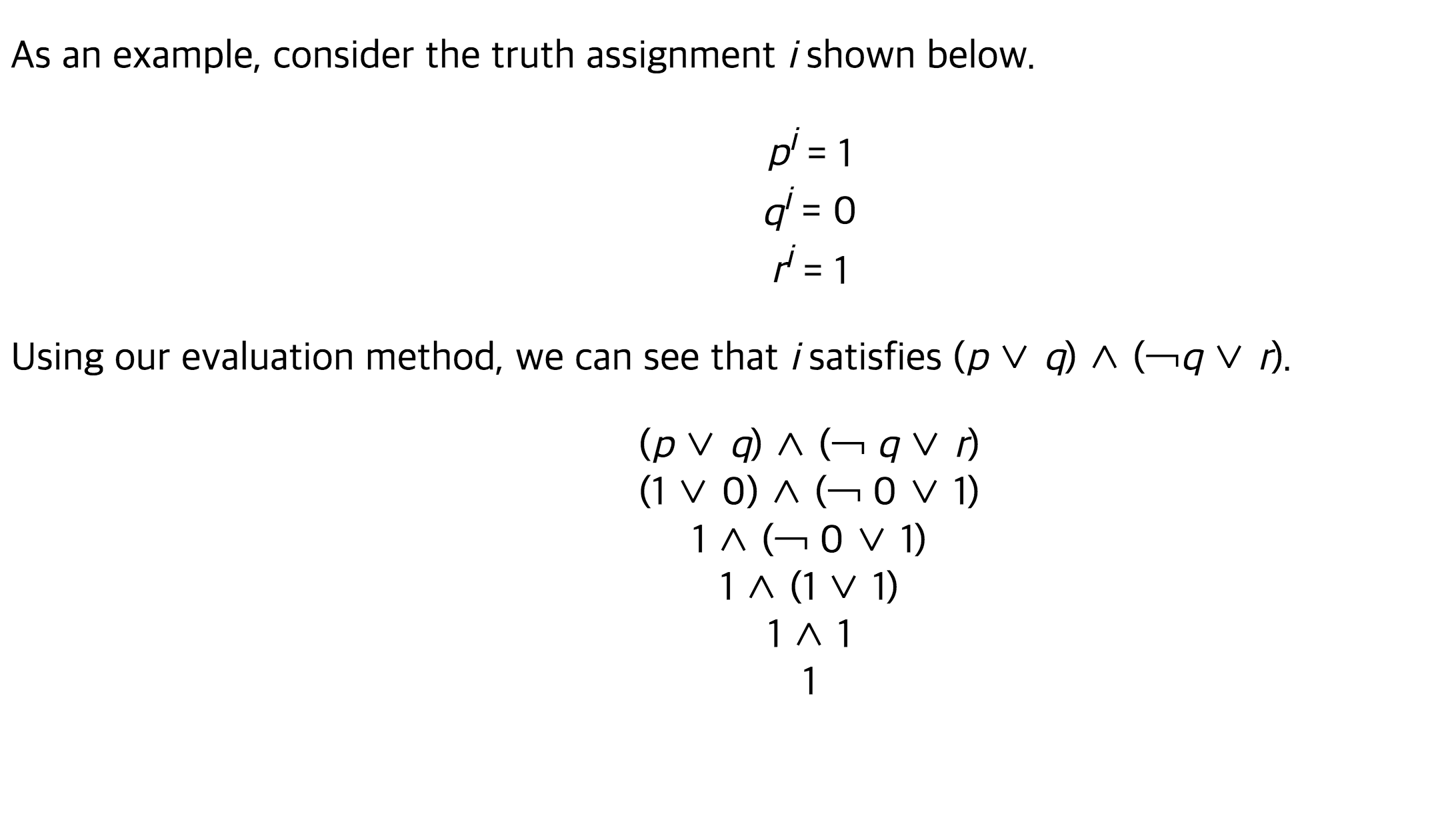
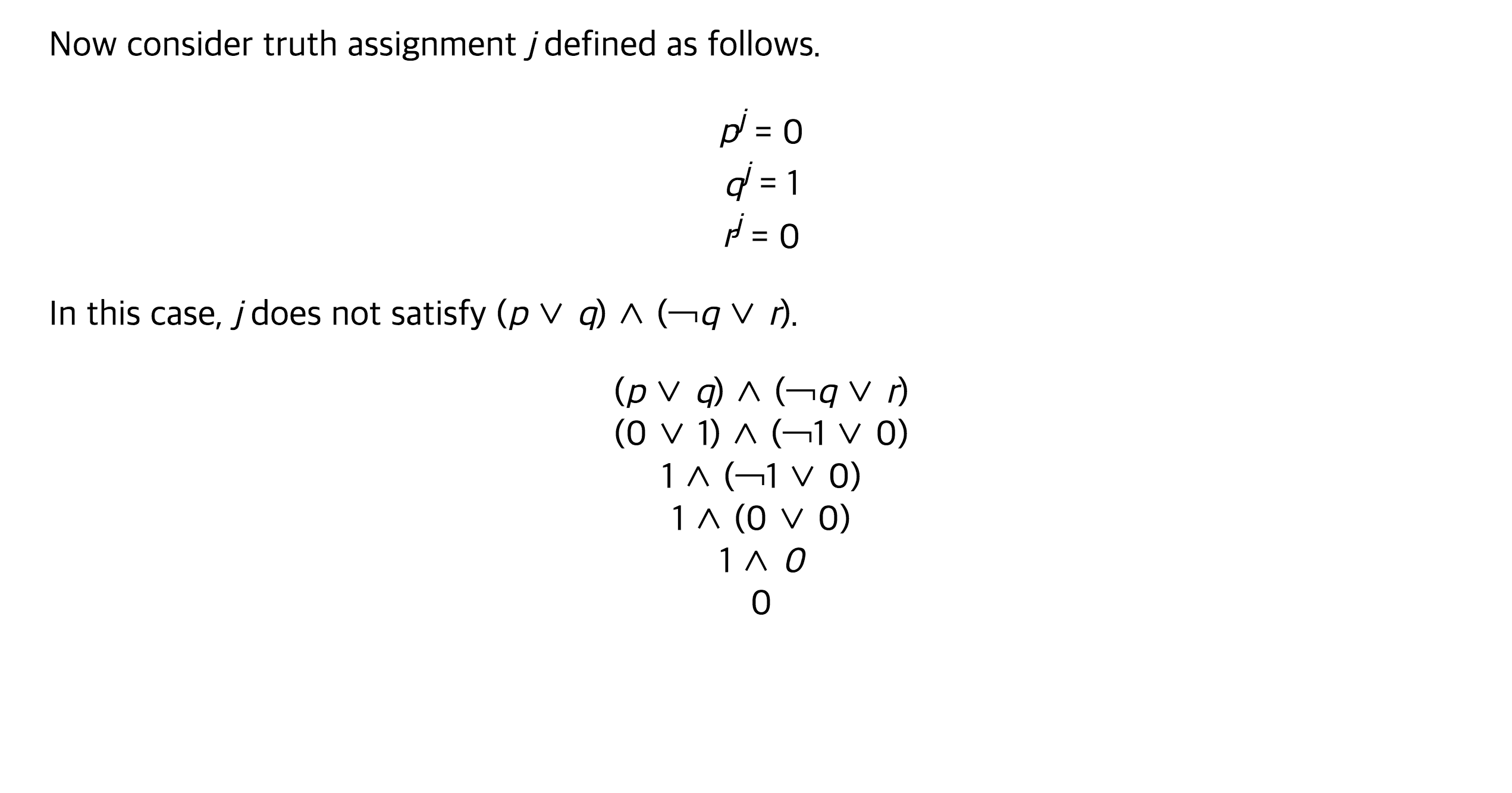
2.5 Satisfaction
2.6 natural language
As an exercise in working with Propositional Logic, let's look at the encoding of various English sentences as formal sentences in Propositional Logic. As we shall see, the structure of English sentences, along with various key words, such as if and no, determine how such sentences should be translated.
The following examples concern three properties of people, and we assign a different proposition constant to each of these properties. We use the constant c to mean that a person is cool. We use the constant f to mean that a person is funny. And we use the constant p to mean that a person is popular.
Next, we have the sentence A person is popular only if he is either cool or funny. This is similar to the previous sentence, but the presence of the phrase only if suggests that the conditionality goes the other way. It is equivalent to the sentence If a person is popular, then he is either cool or funny. And this sentence can be translated directly into Propositional Logic as shown below.
p ⇒ c ∨ f
A person is popular if and only if he is either cool or funny. The use of the phrase if and only if suggests a biconditional, as in the translation shown below. Note that this is the equivalent to the conjunction of the two implications shown above. The biconditional captures this conjunction in a more compact form.
p ⇔ c ∨ f
Finally, we have a negative sentence. There is no one who is both cool and funny. The word no here suggests a negation. To make it easier to translate into Propositional Logic, we can first rephrase this as It is not the case that there is a person who is both cool and funny. This leads directly to the following encoding.
¬(c ∧ f)
Note that, just because we can translate sentences into the language of Propositional Logic does not mean that they are true. The good news is that we can use our evaluation procedure to determine which sentences are true and which are false.
Suppose we were to imagine a person who is cool and funny and popular, i.e. the proposition constants c and f and p are all true. Which of our sentences are true and which are false?
Using the evaluation procedure described earlier, we can see that, for this person, the first sentence is true.
c ∨ f ⇒ p
(1 ∨ 1) ⇒ 1
1 ⇒ 1
1
The second sentence is also true.
p ⇒ c ∨ f
1 ⇒ (1 ∨ 1)
1 ⇒ 1
1
Since the third sentence is really just the conjunction of the first two sentences, it is also true, which we can confirm directly as shown below.
p ⇔ c ∨ f
1 ⇔ (1 ∨ 1)
1 ⇔ 1
1
Unfortunately, the fourth sentence is not true, since the person in this case is both cool and funny.
¬(c ∧ f)
¬(1 ∧ 1)
¬1
0
캬ㅑ캬캬캬캬컄
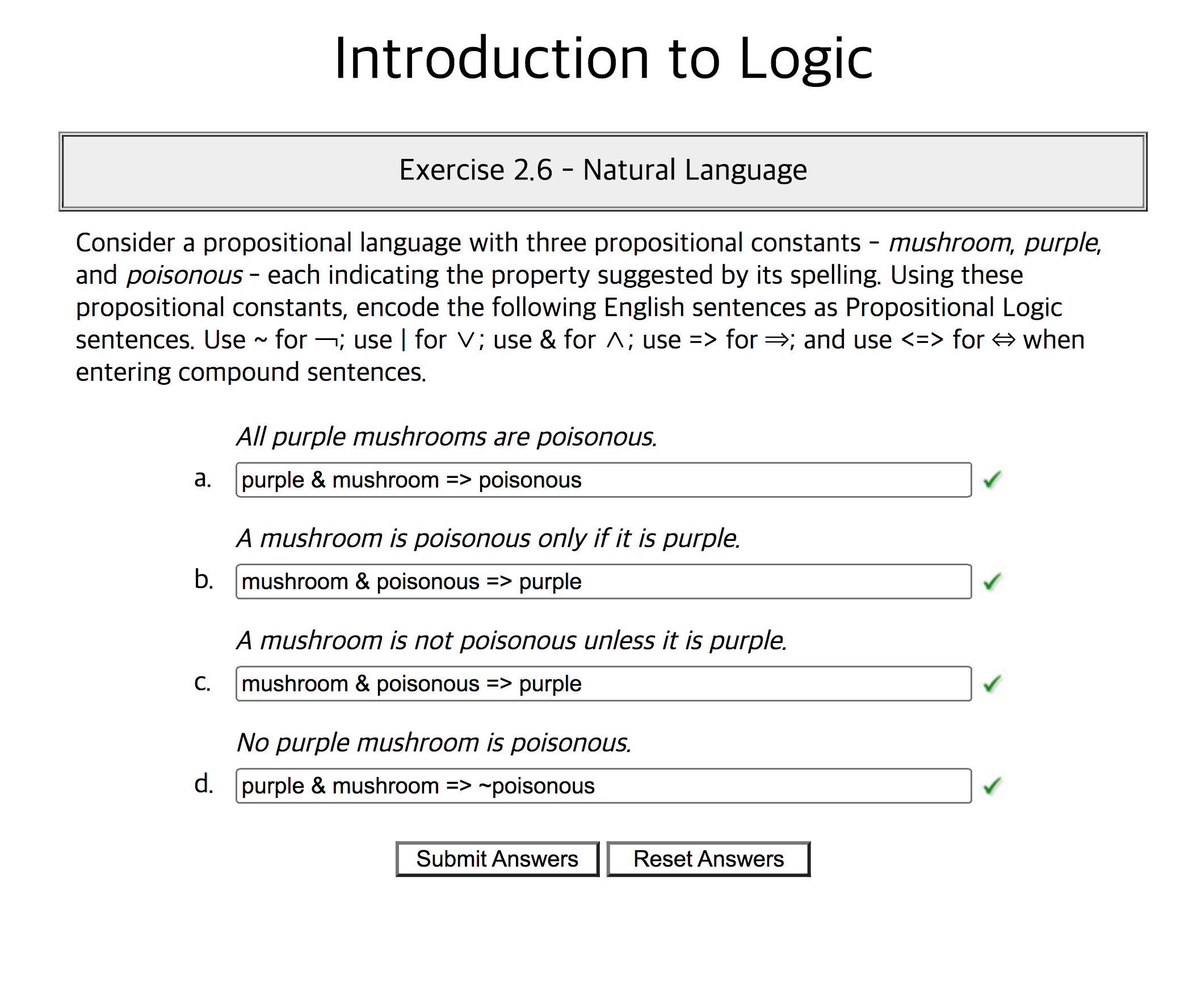



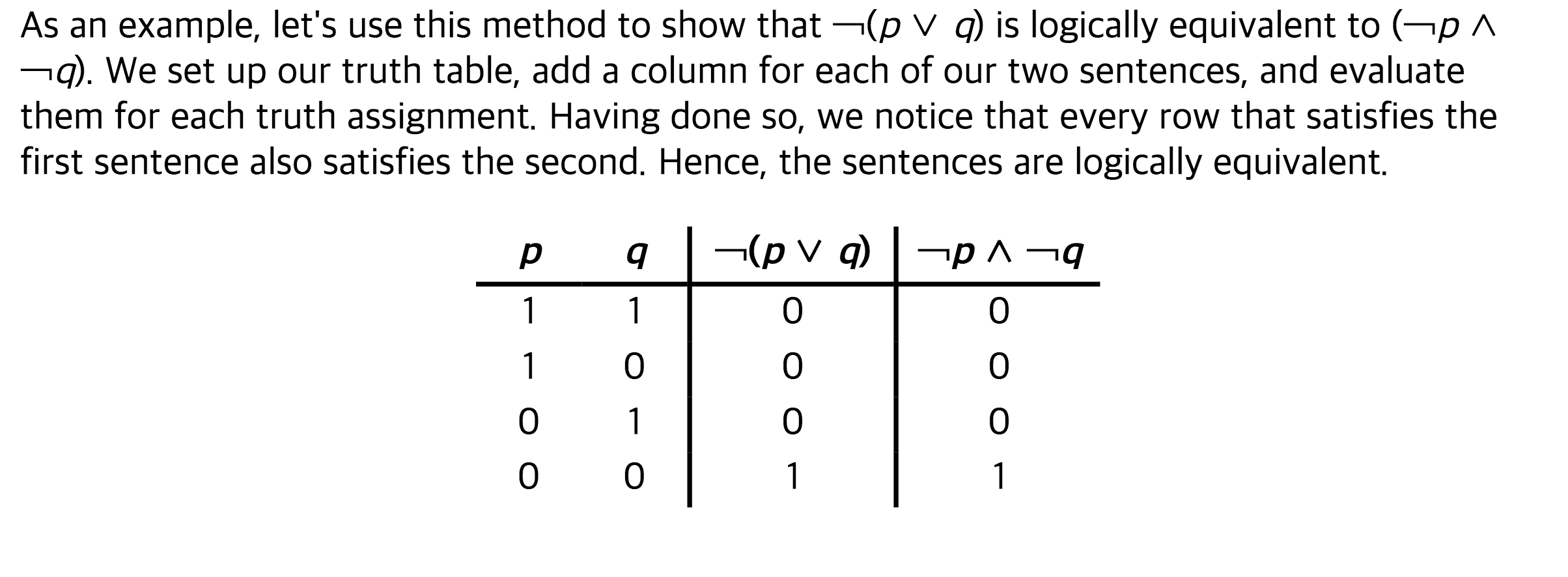
(3.7) Whodunnit
미쳤다 미쳤어
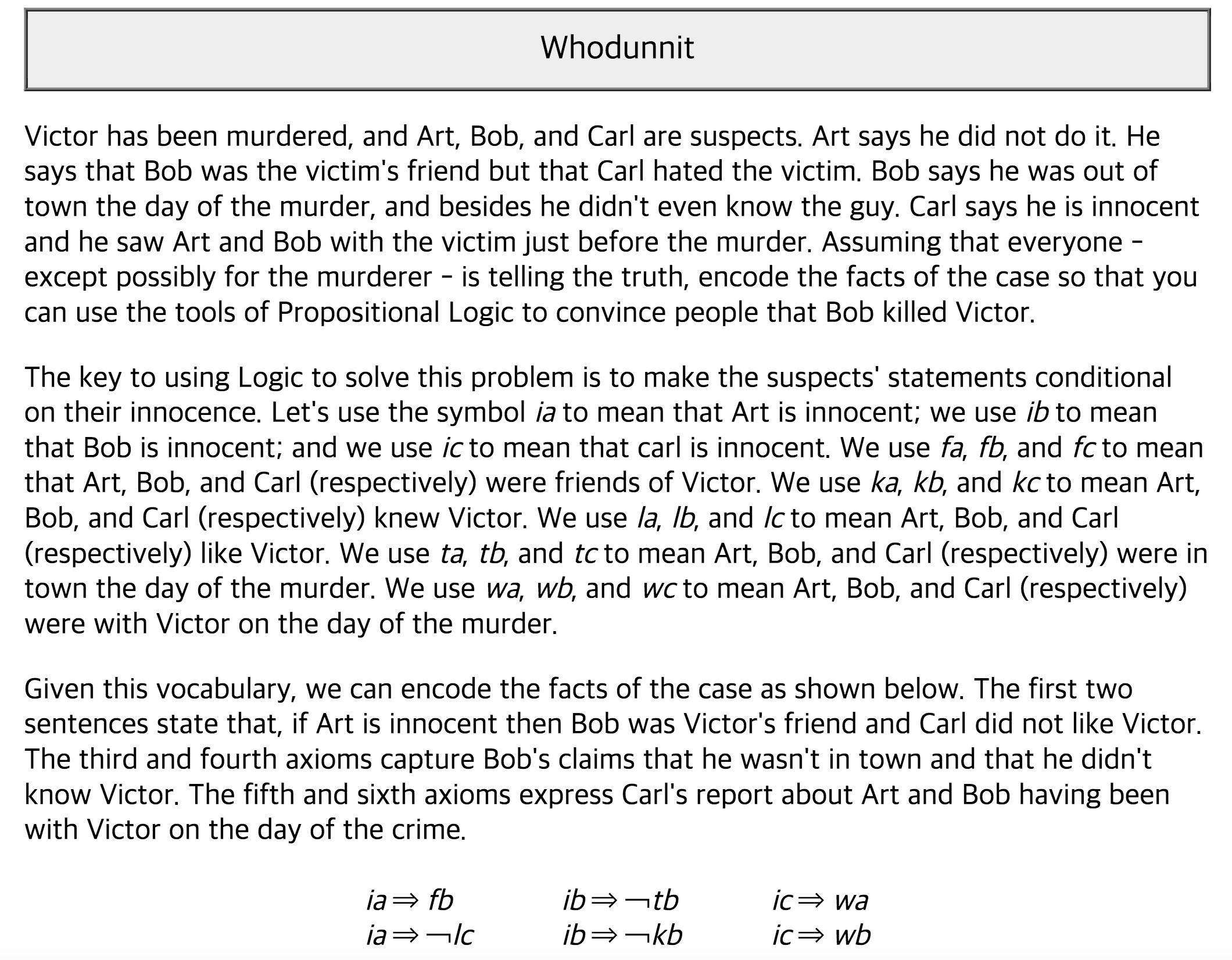
아니 변수를 이렇게? 대단하다 어떻게 이렇게 생각이 들지;;
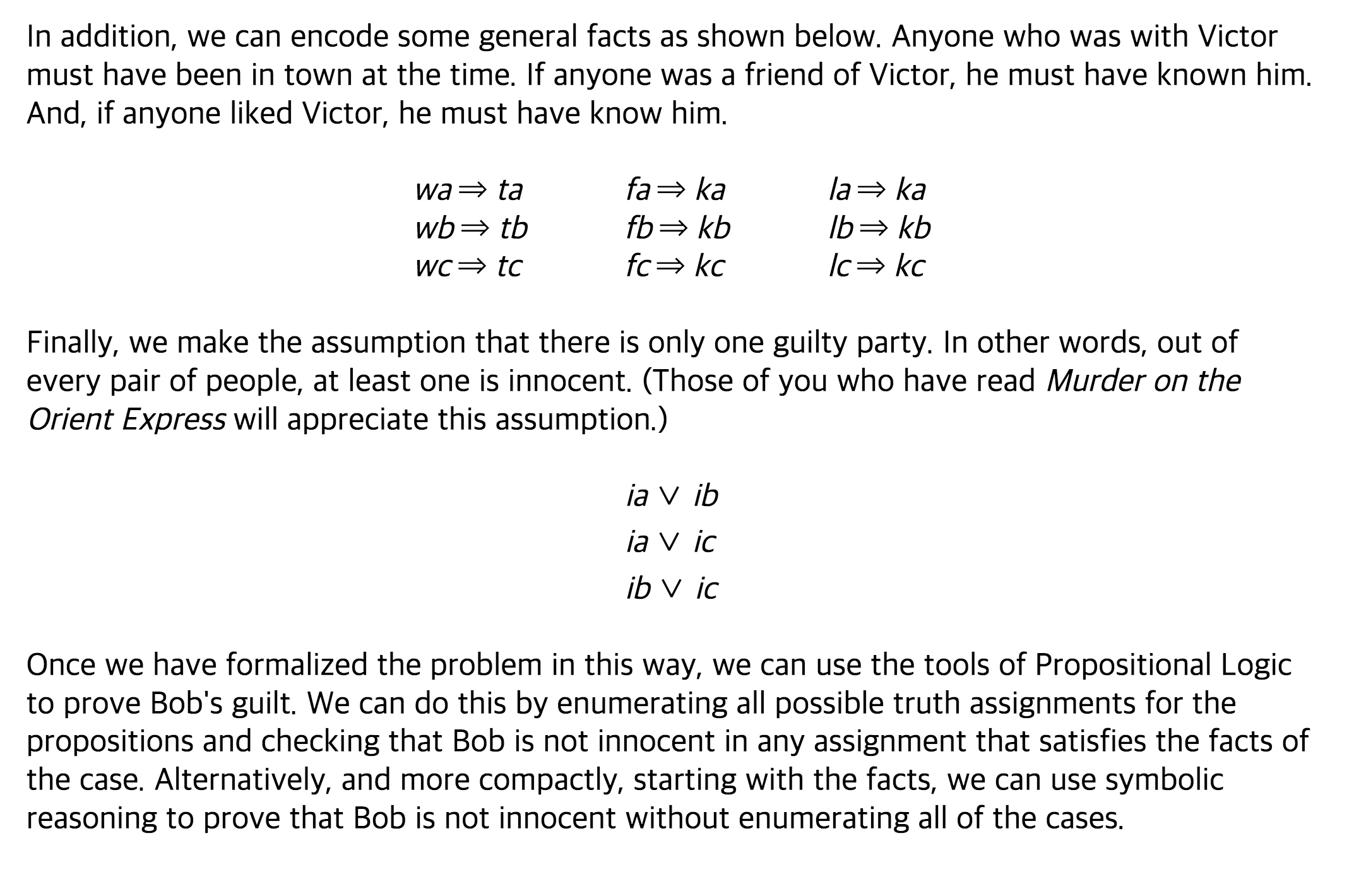
개재밌네 chapter 3은
Section 3.3 - Logical Equivalence
Section 3.4 - Logical Entailment
Section 3.5 - Logical Consistency
이렇게 3가지가 중요 내용인데 와...이걸 저렇게 실생활로 옮기니까 너무 신기하다.
그리고 변수를 정할 때는 각 constants (저기서는 Art, Bob, Carl) 들 모두에게 해당하는 값으로 정해줘야함. 예를 들어
Bob이 Victor의 친구였다~ 는 말만 나와있더라도
Art가 V의 친구일 경우 - 변수 1개
Bob이 V의 친구일 경우 - 변수 2개
Carl이 V의 친구일 경우 - 변수 3개 요렇게 각 경우의 수를 다 지정해줘야함.
이거 생각해보니 행렬로도 표현이 가능할 듯 한데?
반복되는 a,b,c를 옮겨서
여기서 반복되는 [i,f,k,t,w]를 벡터 k라고 하고 [a,b,c]를 벡터 a라고 하면
아씨 원소가 저렇게 반복되는 거 어떻게 나타내지;;;
구글에 '반복되는 열벡터로 이루어진 행렬' 이라고 검색해도 안 나온다...단위행렬을 곱해도 저렇게는 안나올거고 ...음...여튼
거의 스무줄되는 글을 단 여섯개의 간단한 기호로 관계를 표시할 수 있다는게 너무 대단하다.
엥 근데 마지막 이해안감 그래서 뭐 어떻게 조합하라는 건데
4.2 Linear reasoning
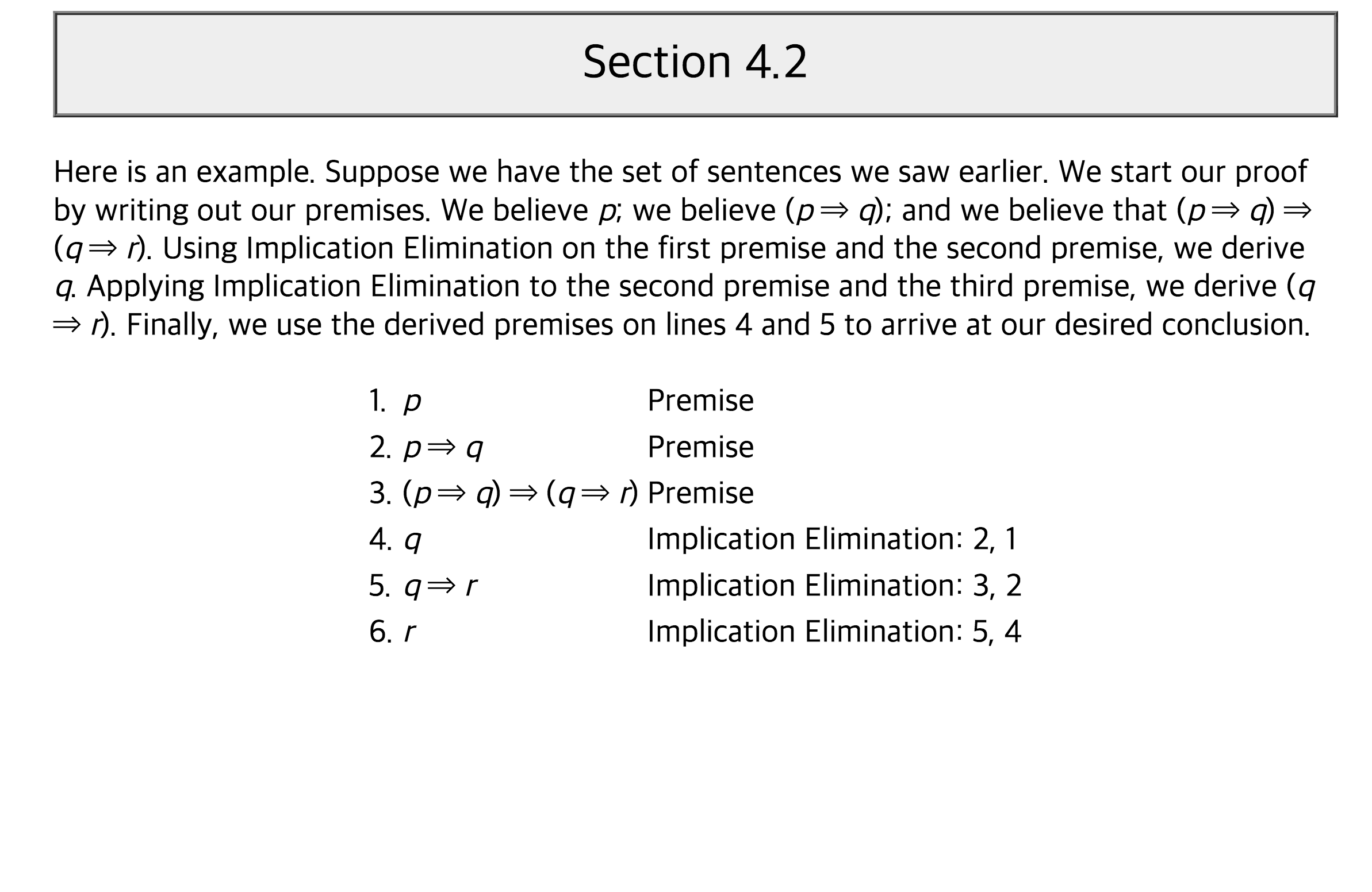
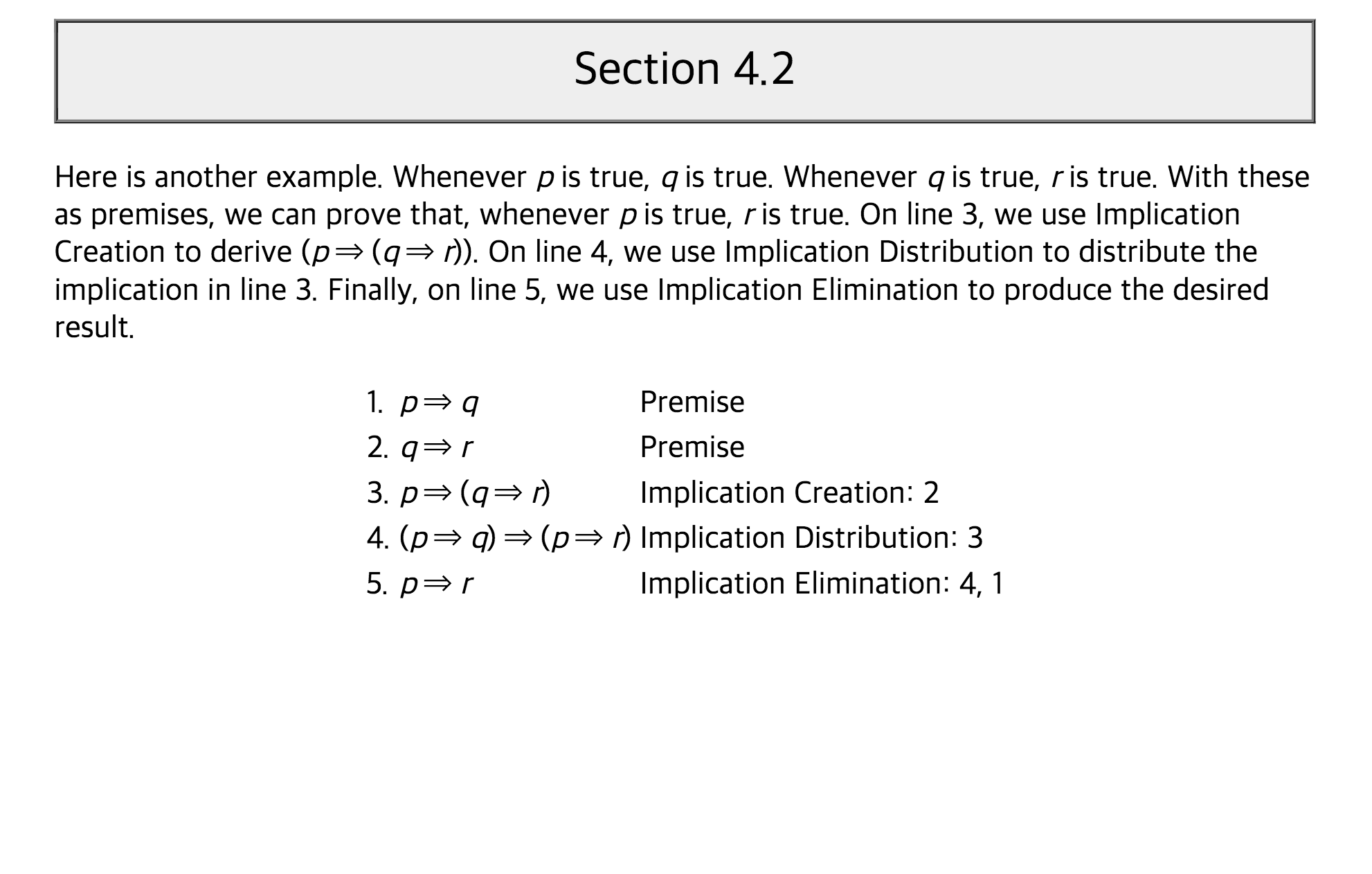
3번...3번은 어렵다.
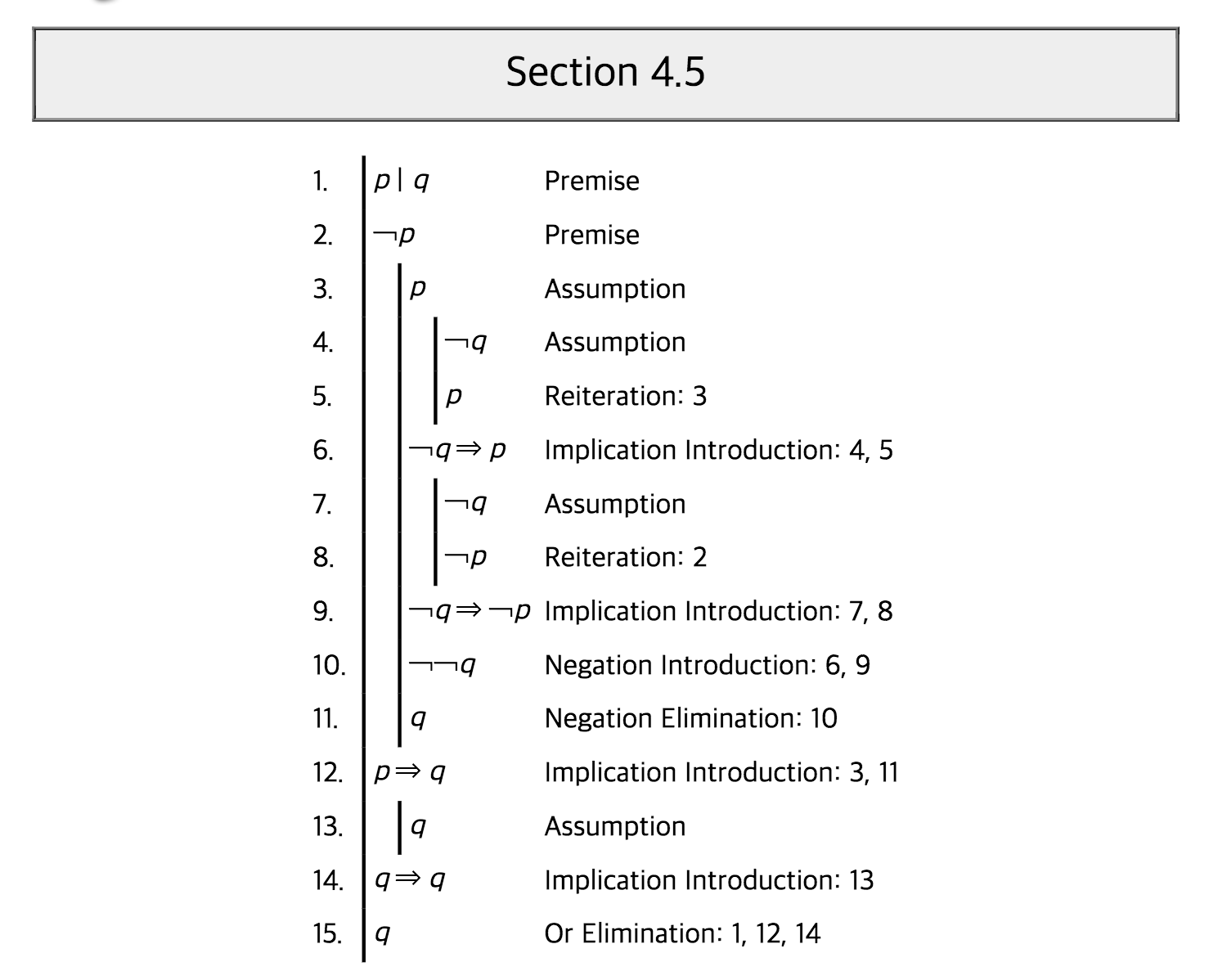
ㅋㅋㅋㅋㅋㅋㅋㅋㅋㅋㅋㅋㅋㅋㅋㅋㅋㅋㅋㅋㅋㅋㅋㅋㅋㅋㅋㅋㅋㅋ 멘붕의 시작
아니 https://youtu.be/EaYEQ30KlWw
있있잖잖아아. 아 진짜 벨벨로로그 또 이이러러네 진진짜 아아우 갈갈아아탄탄다 .
4.3 Fitch exercise
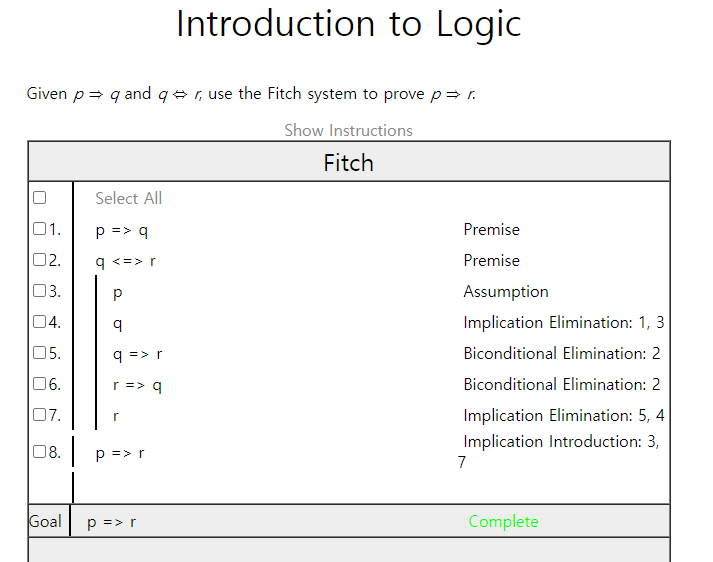
fitch는 그냥 완전 수학임. 아니, 반대지.
수학의 기본 구성원리가 논리라는걸 이번 단원에서 절절히 느낌.
되게 당연한 얘기인데 P가 충분조건이면 당연히 Q는 필요조건이겠지
근데 P랑 R이랑 동치면 둘이 EQUIVALENT하단 거니까 P는 당연히 R의 충분조건임. 그런데 이 당연한 얘기를 설명해봐 라고 하면... 솔직히 추상적임. 근데 FITCH는 각 요소들을 명확히 분류를 해주기 때문에 실제 생활에서도 문제를 만났을 때 유용하게 인과관계를 풀 수 있을 거 같음. Itroduction to logic 너무 좋은 수업임. 우리나라도 이 수업이 꼭 있으면 좋겠음.
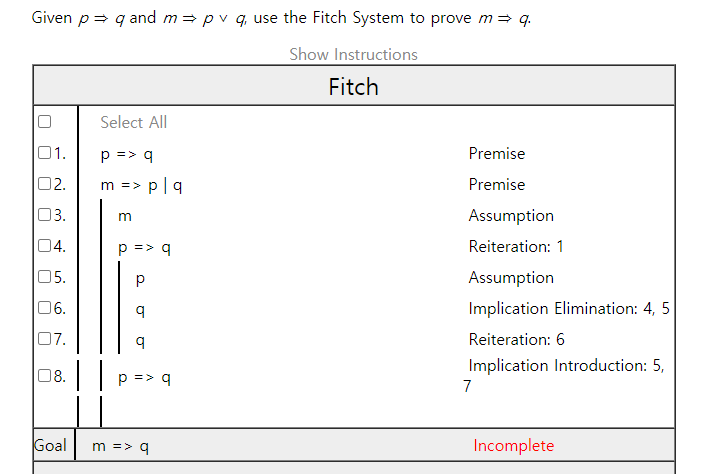
ㅂㄷㅂㄷ
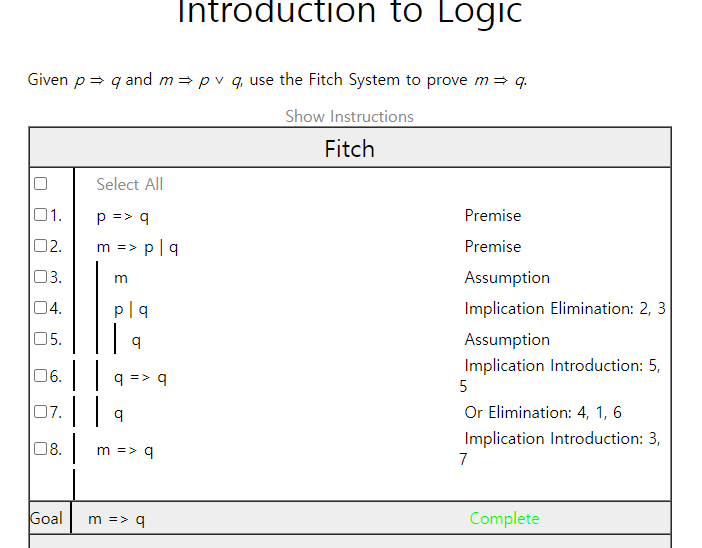
Yes!
근데 7번 Or Elimination여기가 잘 모르겠음
p | q OR p => q OR q => q (이렇게 표현해도...되나?;;;아닌거같은데)
의 값이 q가 되는 이유를 정확히고 싶음
exercise 4.5
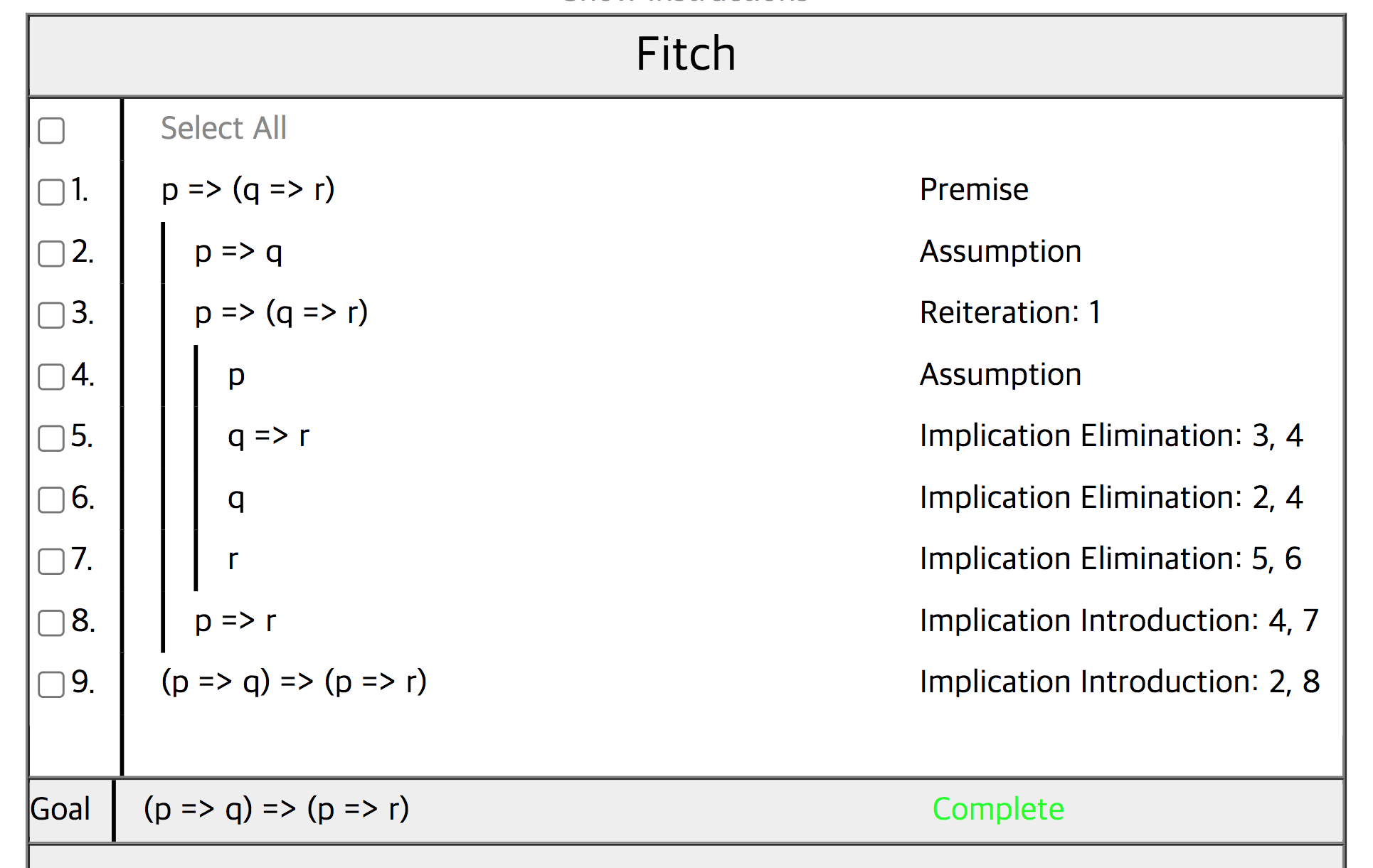
하...
드디어 풀었다
exercise 4.7
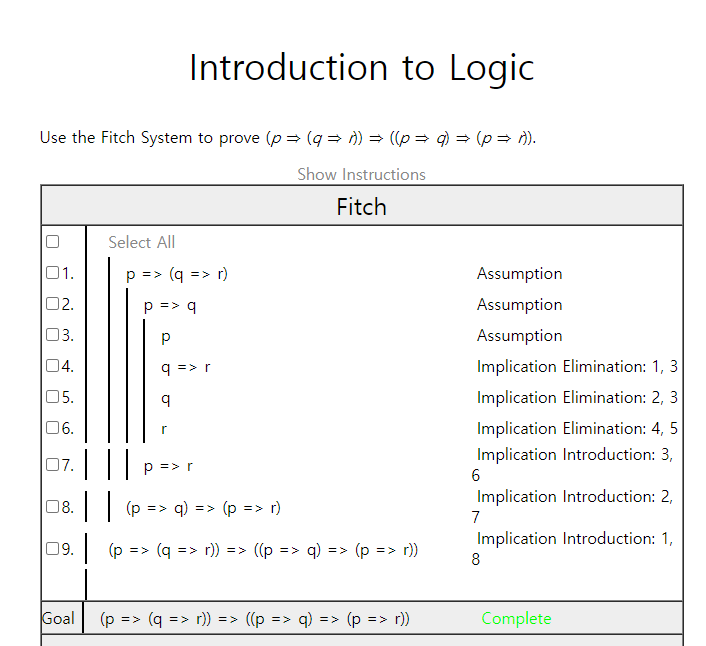
4.6은 되게 금방 풀었었는데 어디다가 놓았는지 모르겠음
하...4.7 진짜 오래걸렸었다. 진짜 마약같네 이거ㅠ 도파미뉴ㅜㅜㅜ
exercise 4.8
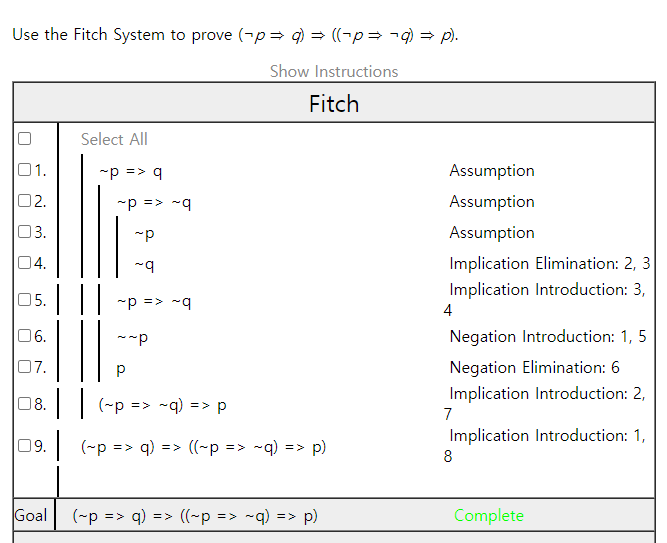
와 실환가? 이거 한 5분만에 풀었음 흐헤헤
exercise 4.9
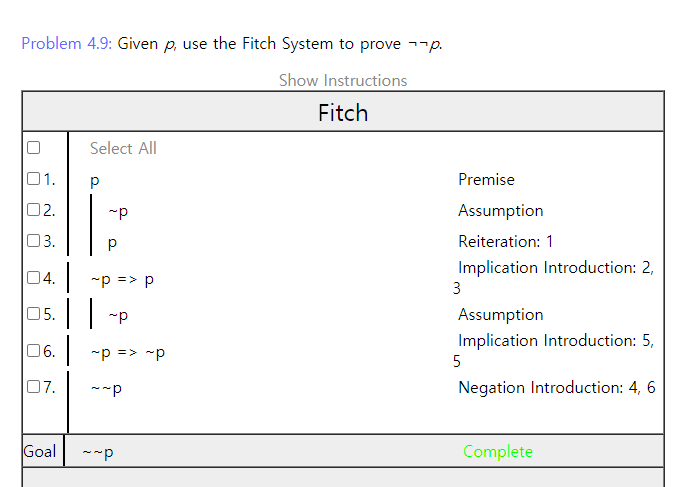
exercise 4.10
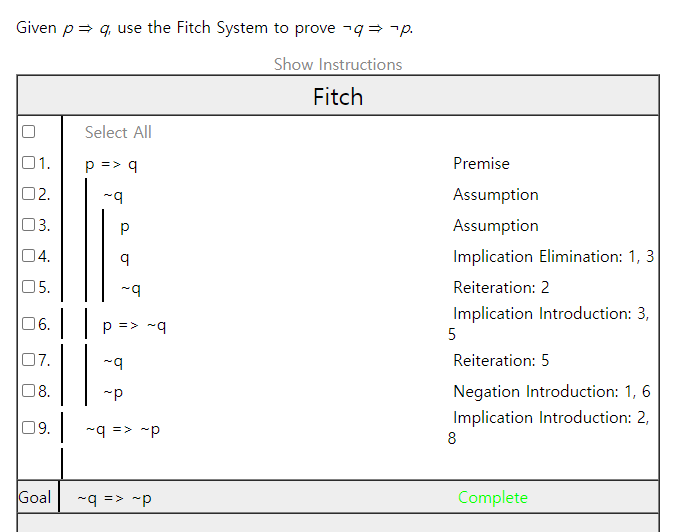
무야호~
exercise 4.11
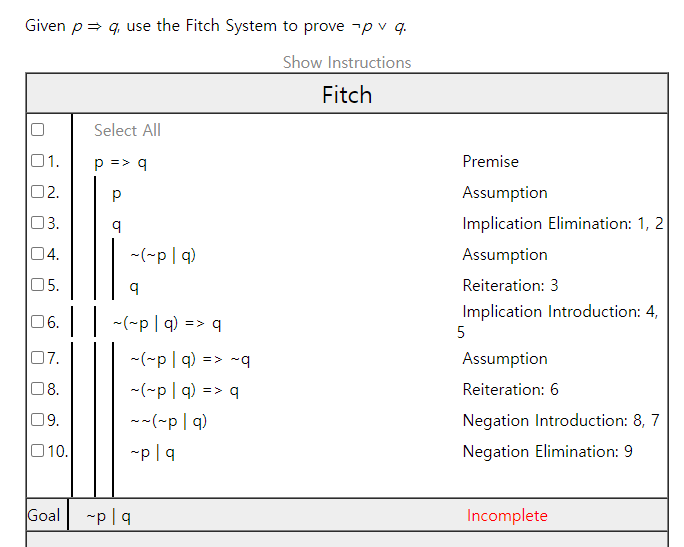
뭐가 문제냐...
exercise 4.12
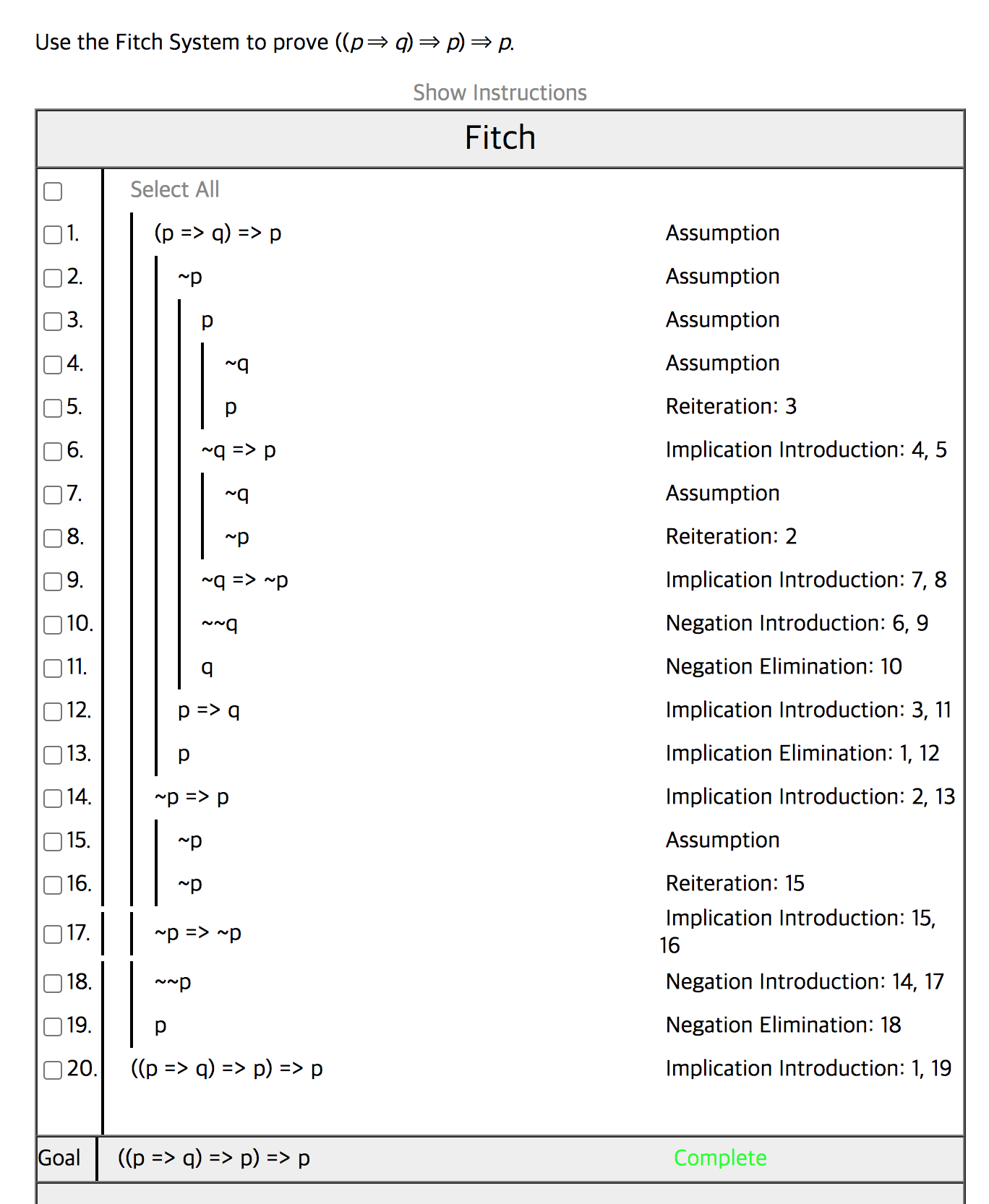
exercise 4.13
~p와 ~q를 &&해도 fail이었다.
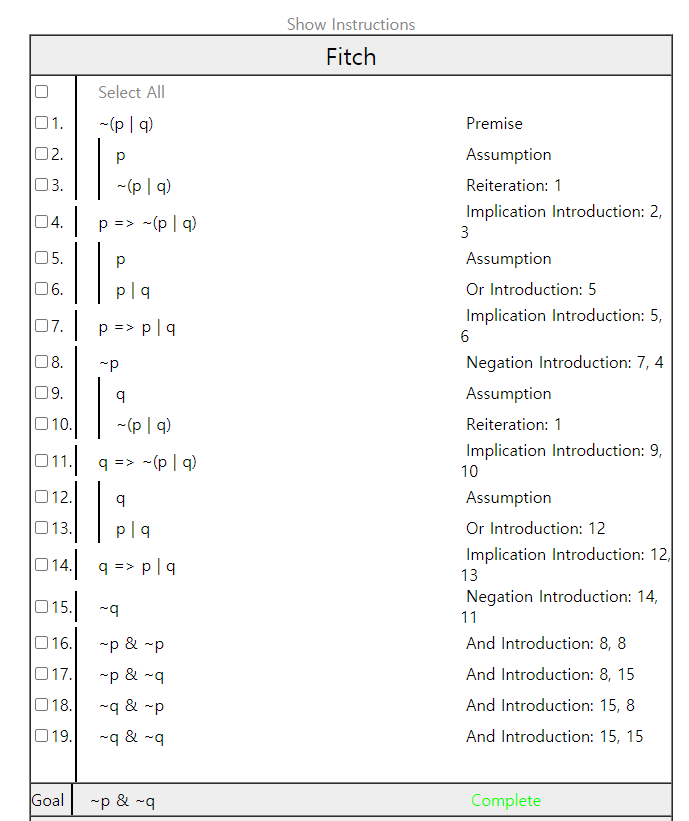
ㅠㅜㅜㅜfinally!
exercise 4.14
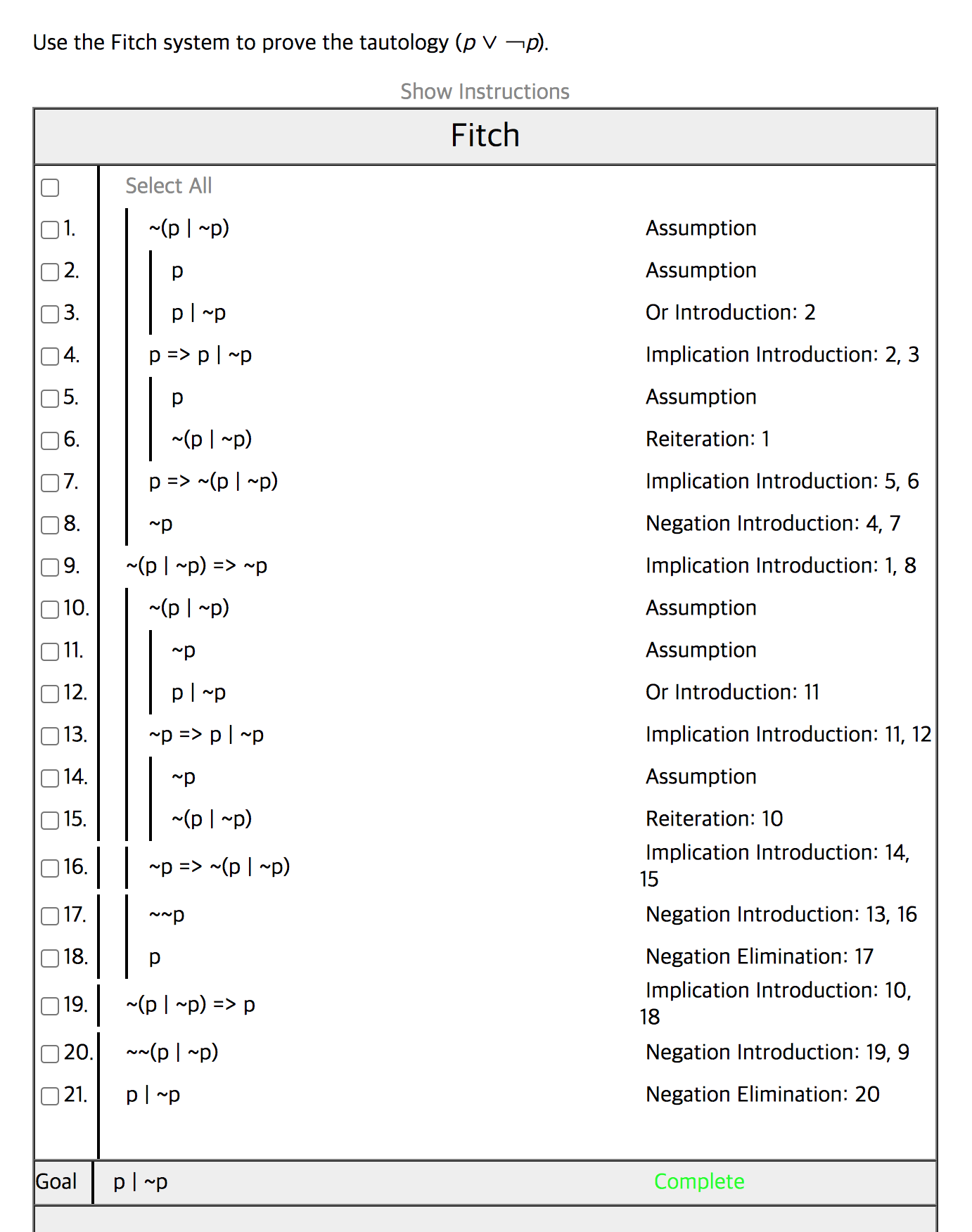
Lesson 5 - Propositional Resolution
Section 5.4 - Resolution Reasoning
오늘은. Introduction to Logic의 설명이 너무 ㅈ같아서
Section 5.4의 문장들을 이해할 수 있게 한 문장씩 독해를 해보려 한다.
꼭 굳이 이렇게 구구절절 길게 써야 하나 문장도 되게 마트료시카처럼 써놓음....ㅅㅂ....외국인 배려해줘....
We define a resolution derivation of a conclusion from a set of premises to be a finite sequence of clauses terminating in the conclusion in which each clause is either a premise or the result of applying the resolution principle to earlier members of the sequence.
내 발번역:
우리는 전제들의 한 세트에서 나온 결론의 resolution derivation을 각 절의 전제거나 앞선 members of the sequence에 대한 resolution 원칙을 적용시킨 결과의 결과 결론 안에서 종료되어지는 절들의 정해진 연속이 될 것이라고 정의하기로 했다.
파파고:
우리는 전제 집합에서 결론의 결의파생은 각 조항이 전제이거나 결의원칙을 이전 구성원에 적용한 결과인 결론에서 종료되는 유한한 절의 순서라고 정의한다.
||
파파고 번역을 바탕으로 뭘 잘못 독해했는지 다시 확인
||
아래 자기전에 꼭 3번 열창하고 자기...
-
a resolution derivation of a conclusion from a set of premises
여기서 from을 ~에서 라고 말하네 -
a set of premises : 전제 집합
-
the result of applying the resolution principle/ to earlier members of the sequence
resolution principle을 적용한 결과 / 이전 구성원에게 -> 여기서 to 가 ~에게 라고 해석 되는구나. 근데 왜 the sequence가 붙는거지? -
a finite sequence of clauses
아…순서…왜 자꾸 연속으로 읽짘ㅋㅋㅋㅋㅋ 순서라고 순서!!!!
